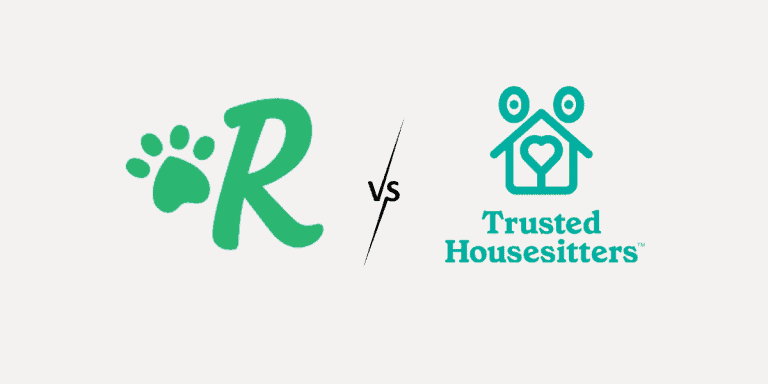5 Common Pet Sitting Challenges and How to Overcome Them

Like with any business, pet sitting can have its challenging moments. Whether you’re a full-time sitter or run your business as a side gig to supplement your income, you should know how to deal with the most common challenges before they happen to you.
A recent survey by the National Association of Professional Pet Sitters found that 78% of pet sitters encounter at least one major challenge in their first year, so it’s good to be prepared.
In this post, I’ll discuss the five most common challenges faced by pet sitters and provide practical solutions to help you navigate these situations with confidence.
Want to know more about the ins and outs of pet sitting in general? Check out this ultimate guide!
#1 Dealing with Difficult Pets
As a pet sitter, you’ll encounter all sorts of animal personalities. While most pets are a joy to care for, some can be a bit more challenging (even the challenging ones can still be a joy!).
Here are some strategies to help you handle even the most difficult furry clients.
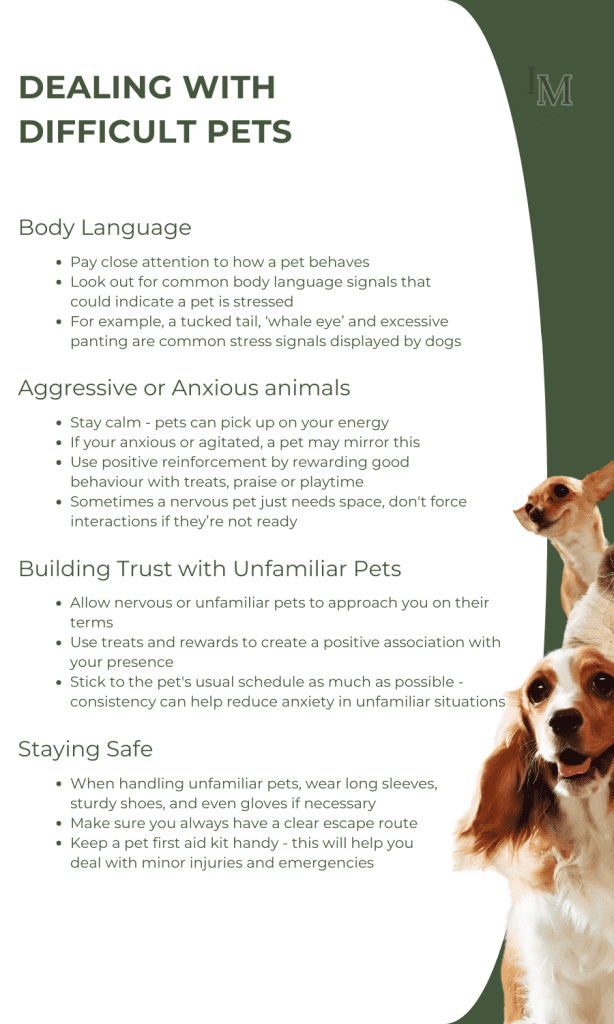
Pet Personalities
Every pet is unique, with their own quirks and behaviours. Some might be shy, others overly energetic, and a few might even be a bit grumpy. It’s important that you approach each pet with patience and understanding.
Body language: Pay close attention to how the pet moves and behaves. A wagging tail doesn’t always mean a happy dog, and a purring cat isn’t always content. Learn to read these subtle cues to gauge a pet’s mood.
Ask the owners: Before taking on a new client, have a chat with the owners about their pet’s personality. If the pet isn’t a good fit for you, politely decline.
Aggressive or Anxious Animals
Dealing with aggressive or anxious pets can be tricky, but as a responsible pet sitter you should be prepared for this situation.
Stay calm: Pets can pick up on your energy. If you’re nervous or agitated, they’ll likely mirror those feelings. Take a deep breath and approach the situation with a calm demeanour.
Use positive reinforcement: Reward good behaviour with treats, praise, or playtime. This can help build trust and encourage better behaviour in the future.
Give them space: Sometimes, the best approach is to give an anxious or aggressive pet some room. Don’t force interactions if the pet isn’t ready.

Building Trust
Some pets have no problem making themselves at home as soon as they walk through your front door. There are others that might take a little longer to feel comfortable in your space. If a pet needs some extra time to build a trusting bond, here’s how to handle it:
Start slow: Allow the pet to approach you on their terms. Sit quietly nearby and let them get used to your presence.
Offer treats: If the owner approves, use treats to create positive associations with your presence. Just be sure to follow any dietary restrictions.
Maintain routines: Stick to the pet’s usual schedule as much as possible. Consistency can help reduce anxiety in unfamiliar situations.
Staying Safe
Your safety should always be a top priority when dealing with difficult pets.
Wear protective gear: When handling unknown or potentially aggressive animals, consider wearing long sleeves, sturdy shoes, and even gloves if necessary.
Know the escape routes: Familiarise yourself with the layout of the home or area where you’re pet sitting. Always ensure you have a clear path to exit if needed.
Carry a pet first-aid kit: Be prepared for minor injuries or emergencies. Your kit should include items like bandages, antiseptic wipes, and tweezers for removing splinters or ticks.
#2 Managing Time and Scheduling
Even without a pet sitting business to run, you’re probably busy. Keeping on top of your bookings and using your time efficiently will help you keep your business ticking over and stop you from getting overwhelmed.
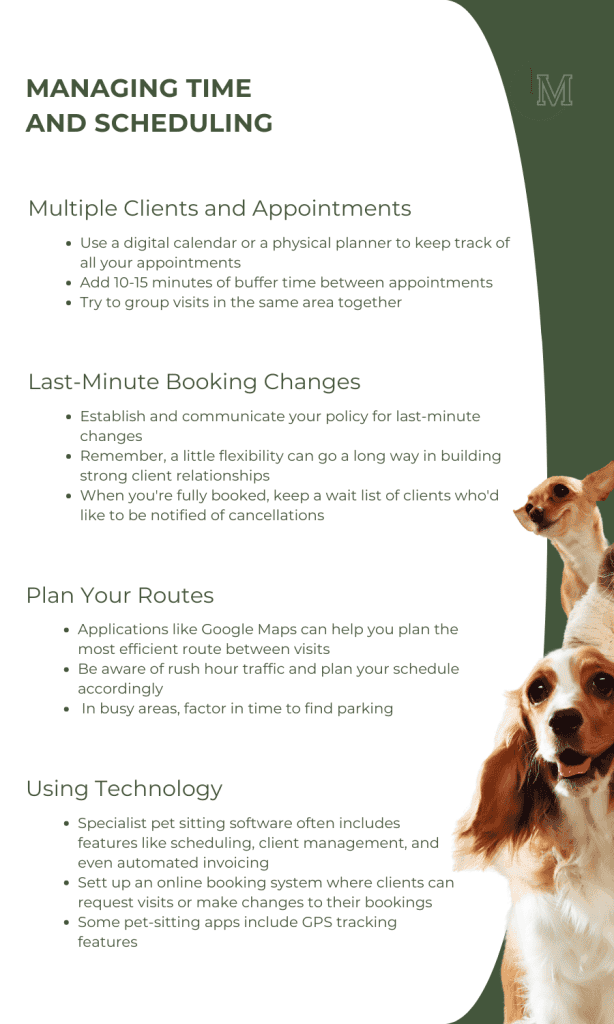
Balancing Multiple Clients and Appointments
You’ll likely be caring for more than one animal in a day, and if you offer dog walks, you’ll likely be heading to more than one location too. It’s a job that requires careful planning and excellent time management skills.
Create a master schedule: Use a digital calendar or a physical planner to keep track of all your appointments. Colour-code entries for different clients or types of visits (e.g., dog walks, overnight stays, feeding visits) to get a quick visual overview of your day.
Buffer time: Always add 10-15 minutes of buffer time between appointments. This allows for unexpected delays, traffic, or those times when Fluffy decides to play hide-and-seek right when you need to leave.
Cluster appointments: Try to group visits in the same area together. This reduces travel time and makes your day more efficient. You might even be able to squeeze in an extra client!
Handling Last-Minute Booking Changes
Stuff happens. Clients may need to adjust their schedules, and you need to be prepared to roll with the punches.
Have a clear policy: Establish and communicate your policy for last-minute changes. For example, you might require 24 hours’ notice for cancellations or charge a fee for same-day changes.
Keep a flexible mindset: While policies are important, remember that emergencies happen. A little flexibility can go a long way in building strong client relationships.
Use wait lists: When you’re fully booked, keep a wait list of clients who’d like to be notified of cancellations. This way, you can quickly fill unexpected openings.

Plan Your Routes
Smart route planning can save you time, petrol, and stress. Here’s how to optimise your daily travels:
Use mapping tools: Applications like Google Maps or specialised pet-sitting software can help you plan the most efficient route between visits.
Consider traffic patterns: Be aware of rush hour traffic and plan your schedule accordingly. You might need to adjust visit times to avoid getting stuck in jams.
Plan for parking: In busy areas, factor in time to find parking. You might even want to scout out good parking spots in advance for new clients.
Using Technology to Streamline Scheduling
We all love cool tech. Ok, not all of us, but I do. Some of it is even actually useful.
Pet-sitting software: Invest in specialised pet-sitting software like Time To Pet or Leashtime. These tools often include features like scheduling, client management, and even automated invoicing.
Online booking systems: Consider setting up an online booking system where clients can request visits or make changes to their bookings. This can reduce the time you spend on phone calls and emails.
GPS tracking: Some pet-sitting apps include GPS tracking features. This can help you prove to clients that you’ve completed visits and can be handy for your own record-keeping.
#3 Communicating with Pet Owners
Effective communication builds trust, sets expectations, and ensures both you and the pet owners are on the same page, so it’s an important skill to master.

Set Clear Expectations with Clients
From the get-go, you need to establish clear guidelines about your services. This helps prevent misunderstandings and helps your interactions run smoothly.
Create a detailed service agreement: Outline what your service includes (and what it doesn’t). Will you administer medications? Do you charge extra for late-night visits? Put it all in writing.
Discuss pet routines: Get a thorough understanding of the pet’s daily routine. What time do they eat? How long should walks be? Are there any quirks or habits you should know about?
Emergency procedures: Make sure you have a plan in place for emergencies. Who should you contact if something goes wrong? Is there a preferred vet?
Provide Updates and Progress Reports
Pet owners love to know how their furry friends are doing while they’re away. Regular updates can provide peace of mind and show your dedication to your job.
Agree on update frequency: Some owners might want daily updates, while others are happy with an occasional check-in. Discuss this upfront and set a schedule that works for both of you. Check out our post on pet sitting report cards for an idea of where to start.
Use photos and videos: A picture is worth a thousand words, especially when it comes to pets. Send photos or short videos of the pets during your visits. It’s a simple way to brighten the owner’s day and show that their pet is happy and well-cared for.
Be honest but tactful: If there are any issues, report them promptly but calmly. For example, if Fluffy isn’t eating well, you might say, “Fluffy seems a bit off her food today. I’ve tried a few things to tempt her, and I’ll keep a close eye on her eating habits.”
Handling Owner Concerns and Complaints
Even with the best care, sometimes things don’t go as planned. Handling concerns professionally will help you maintain good relationships with your clients and keep your reputation intact.
Listen actively: When an owner raises a concern, give them your full attention. Let them express their worries without interruption.
Respond promptly: Address concerns as quickly as possible. Even if you don’t have an immediate solution, acknowledging the issue shows you take their concerns seriously.
Establish Boundaries for Work Hours
While you want to be available for your clients, it’s important to set boundaries to maintain a healthy work-life balance.
Set working hours: Clearly communicate your regular working hours. For example, you might decide that you’ll respond to non-emergency messages between 8am and 8pm.
Use an auto-responder: Set up an email auto-responder or voicemail message that informs clients of your working hours and what to do in case of emergencies.
Emergency protocol: Have a clear policy for what constitutes an emergency and how you’ll handle after-hours calls. Make sure clients understand this policy from the start.
Remember, good communication is a two-way street. Encourage pet owners to share information with you too. The more you know about their pets, their preferences, and their concerns, the better service you can provide.
#4 Handling Pet Health Emergencies
As a pet sitter, you’re not just there for cuddles and playtime. You’re the first line of defence when it comes to a pet’s health and safety. Knowing how to handle pet health emergencies can mean the difference between a happy outcome and a tragic one.
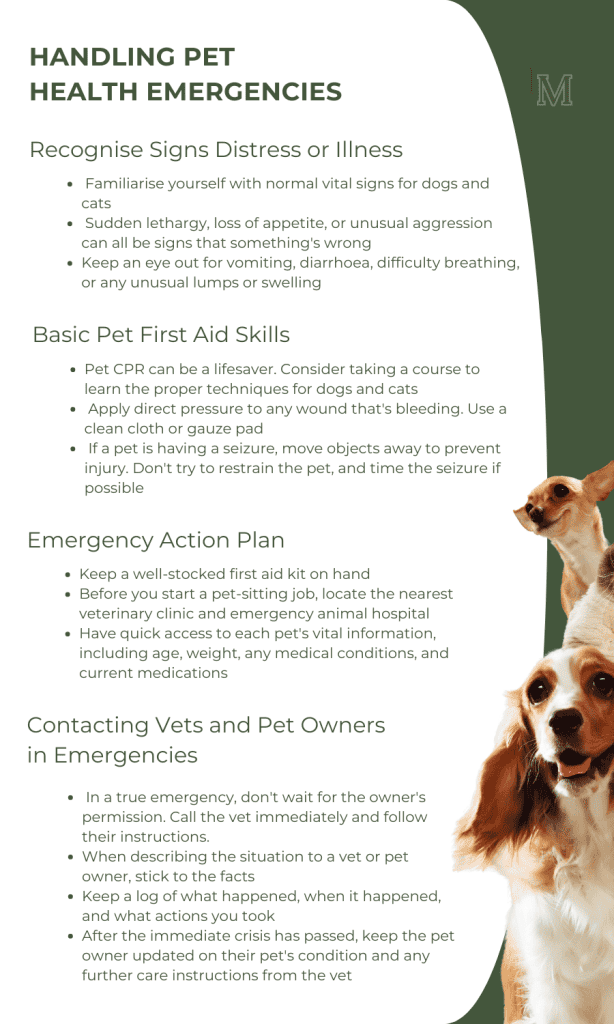
Recognise Signs of Pet Distress or Illness
The first step in handling pet health emergencies is knowing when something’s not right. Pets can’t tell us when they’re feeling poorly, so it’s up to us to spot the signs.
Know the basics: Familiarise yourself with normal vital signs for dogs and cats. For instance, a dog’s normal temperature is between 38.3°C to 39.2°C (101°F to 102.5°F).
Watch for behavioural changes: Sudden lethargy, loss of appetite, or unusual aggression can all be signs that something’s wrong.
Physical symptoms: Keep an eye out for vomiting, diarrhoea, difficulty breathing, or any unusual lumps or swellings.
Basic Pet First Aid Skills
While you’re not expected to be a vet, having some basic first aid skills can make a big difference in an emergency.
Learn CPR for pets: Pet CPR can be a lifesaver. Consider taking a course to learn the proper techniques for dogs and cats.
Stop bleeding: Apply direct pressure to any wound that’s bleeding. Use a clean cloth or gauze pad.
Handle seizures safely: If a pet is having a seizure, move objects away to prevent injury. Don’t try to restrain the pet, and time the seizure if possible.
Treat heatstroke: If you suspect heatstroke, move the pet to a cool area immediately. Use lukewarm (not cold) water to wet their fur, and offer small amounts of water to drink.

Create an Emergency Action Plan
Being prepared can help you stay calm and act quickly in an emergency.
Have a pet first aid kit: Keep a well-stocked first aid kit on hand. Include items like gauze, non-stick bandages, tweezers, and a digital thermometer.
Know the nearest vet: Before you start a pet-sitting job, locate the nearest veterinary clinic and emergency animal hospital. Save their numbers in your phone.
Keep pet info handy: Have quick access to each pet’s vital information, including age, weight, any medical conditions, and current medications.
Practice scenarios: Run through potential emergency scenarios in your mind. What would you do if a dog started choking? How would you handle a cat with a sudden limp?
Contacting Vets and Pet Owners in Critical Situations
When an emergency strikes, clear communication is key.
Call the vet first: In a true emergency, don’t wait for the owner’s permission. Call the vet immediately and follow their instructions.
Be clear and concise: When describing the situation to a vet or pet owner, stick to the facts. What symptoms are you seeing? When did they start? What actions have you taken so far?
Document everything: Keep a log of what happened, when it happened, and what actions you took. This can be vital information for the vet and the pet owner.
Follow up: After the immediate crisis has passed, keep the pet owner updated on their pet’s condition and any further care instructions from the vet.
Remember, your role in a pet health emergency is to act as a responsible caretaker. You’re not expected to diagnose or treat serious conditions, but your quick action and clear communication can make all the difference.
#5 Maintaining Work-Life Balance
As a pet sitter, your job is to care for animals. But who’s taking care of you? Maintaining a healthy work-life balance isn’t just good for your health and well-being, it will also help you provide better care when you’re spending your energy on your pet sitting business.
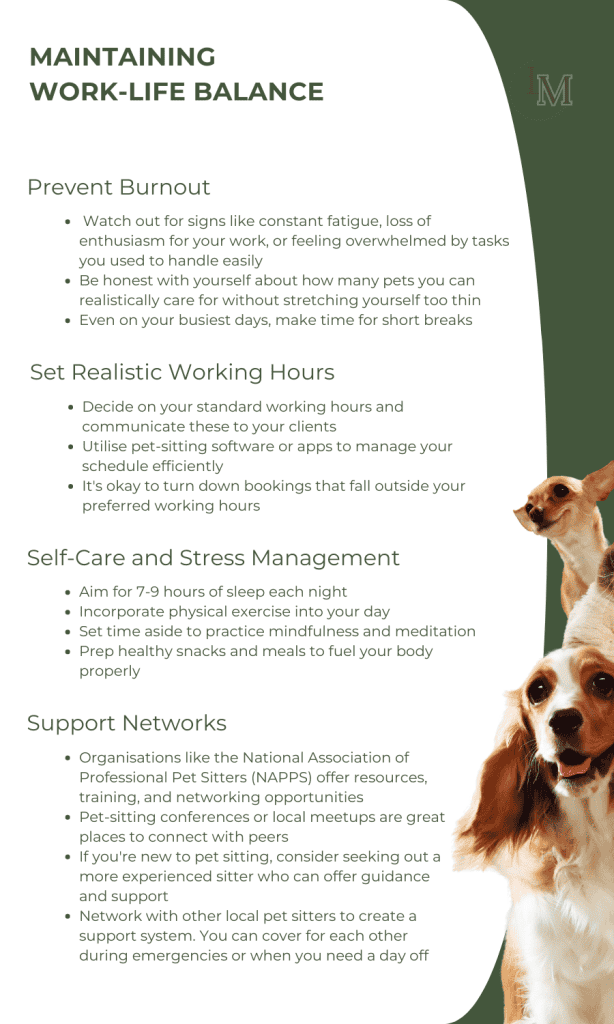
Prevent Burnout
Pet sitting can be physically and emotionally demanding. Long hours, irregular schedules, and the responsibility of caring for beloved pets can take their toll if you’re not careful.
Recognise the signs: Burnout doesn’t happen overnight. Watch for signs like constant fatigue, loss of enthusiasm for your work, or feeling overwhelmed by tasks you used to handle easily.
Set realistic workloads: It’s tempting to take on every client who comes your way, but overbooking yourself is a fast track to burnout. Be honest about how many pets you can realistically care for without stretching yourself too thin.
Take regular breaks: Even on your busiest days, make time for short breaks. A 10-minute breather between pet visits can do wonders for your energy levels.
Set Realistic Working Hours
One of the perks of pet sitting is the flexible schedule, but that flexibility can sometimes lead to working around the clock if you’re not careful.
Define your work hours: Decide on your standard working hours and communicate these to your clients. For example, you might choose to work from 7am to 7pm, with emergency services available outside these hours for an additional fee.
Use scheduling tools: Utilise pet-sitting software or apps to manage your schedule efficiently. This can help you visualise your workload and avoid overbooking.
Learn to say no: It’s okay to turn down bookings that fall outside your preferred working hours. Your time off is valuable and necessary for your well-being.
Self-Care and Stress Management
Taking care of yourself is just as important as taking care of the pets in your charge.
Prioritise sleep: Aim for 7-9 hours of sleep each night. Good sleep hygiene can improve your mood, energy levels, and ability to handle stress.
Exercise regularly: Physical activity is a great stress-buster. Why not combine it with your job? Power walks with energetic dogs or play sessions with active cats can count towards your daily exercise.
Practice mindfulness: Take a few minutes each day for mindfulness or meditation. Apps like Headspace or Calm can guide you through short, effective sessions.
Eat well: Don’t let your busy schedule lead to skipped meals or constant fast food. Prep healthy snacks and meals in advance to fuel your body properly.
Support Networks
Building connections with other pet sitters can provide both practical and emotional support.
Join professional associations: Organisations like the National Association of Professional Pet Sitters (NAPPS) offer resources, training, and networking opportunities.
Attend industry events: Pet-sitting conferences or local meetups are great places to connect with peers, share experiences, and learn new strategies for managing your business and your life.
Find a mentor: If you’re new to pet sitting, consider seeking out a more experienced sitter who can offer guidance and support.
Create a backup system: Network with other local pet sitters to create a support system. You can cover for each other during emergencies or when you need a day off.
Conclusion: Overcoming Pet Sitting Challenges
Pet sitting is a rewarding but challenging profession. From managing difficult pets to juggling schedules, communicating with owners, handling emergencies, and maintaining work-life balance, pet sitters face unique challenges. With the right strategies and mindset, these challenges can be transformed into opportunities for growth and excellence.
Every challenge you overcome makes you a better, more experienced pet sitter.
Those tricky pets become opportunities to hone your animal handling skills. Scheduling conflicts push you to become more organised and efficient. Communication hurdles help you become a better listener and more articulate professional. Emergencies, while stressful, equip you with invaluable experience and quick-thinking skills. And learning to balance work and life? That skill will serve you well in all aspects of your life.






